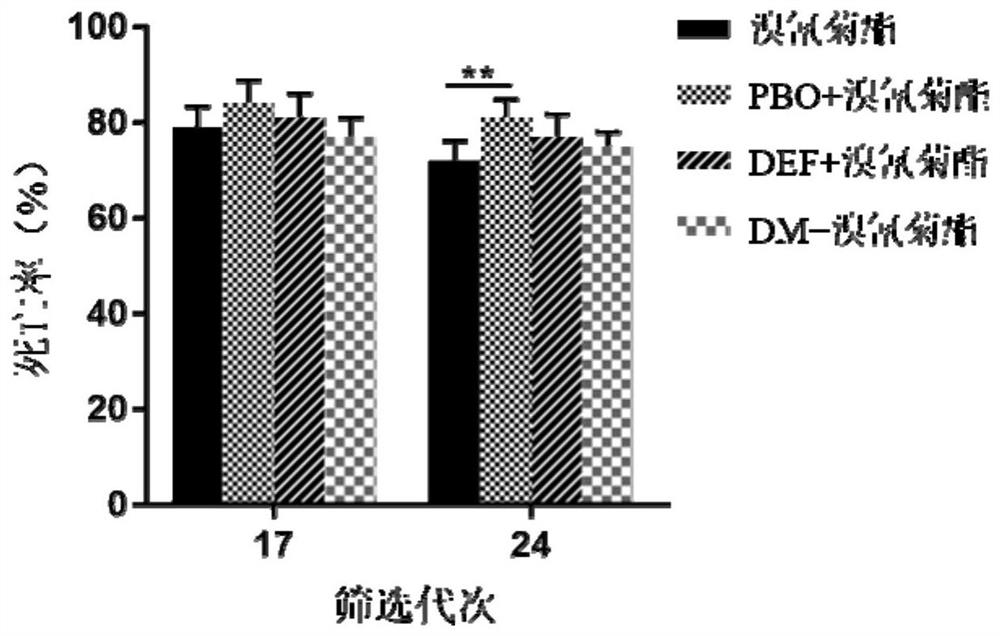Aedes albopictus molecular marker related to deltamethrin insecticide resistance, primer and application
A molecular marker, Aedes albopictus technology, applied in the field of molecular biology, can solve the problem of no mosquito function verification report and other problems
- Summary
- Abstract
- Description
- Claims
- Application Information
AI Technical Summary
Problems solved by technology
Method used
Image
Examples
Embodiment 1
[0044] Example 1 Screening of laboratory Aedes albopictus deltamethrin-resistant populations
[0045] The sensitive strain of Aedes albopictus in the laboratory comes from the sensitive strain domesticated and bred by Shanghai Center for Disease Control and Prevention. The offspring hatched by laying eggs of this sensitive population is used as the first generation population, and each generation is screened. Before each generation of screening, at first measure the median lethal concentration of contemporary larvae (see table 1 in embodiment 2), then add in the special-purpose steel basin of screening with the deltamethrin liquid medicine of the corresponding concentration that is configured into 1L volume with contemporary median lethal concentration, Then add about 1000 third-instar Aedes albopictus larvae for screening, and after 24 hours, suck out the surviving larvae with a straw and transfer them to dechlorinated tap water for further feeding and passage. Use 2 / 3 of th...
Embodiment 2
[0046] Embodiment 2 Aedes albopictus larvae resistance detection
[0047] The larvae were selected by the larva dipping method recommended by the World Health Organization for the determination of larval drug resistance, and the half lethal concentration (LC) of the test population was obtained. 50 ).
[0048] First, accurately weigh the deltamethrin standard (94.62%, provided by the Chinese Center for Disease Control and Prevention), and use acetone as a solvent to prepare a mother solution and dilute to obtain 1 mL of the drug solution with different concentrations for use. Mix 25 3-4 instar Aedes albopictus larvae with 99mL dechlorinated tap water and different concentrations of liquid medicine into a disposable paper cup as the experimental group, and the control group is made by mixing 99mL dechlorinated tap water and 1mL acetone. Three replicates were set up for each test concentration and control group. The test is carried out in the pre-experiment first, and generall...
Embodiment 3
[0055] Example 3 Detection of Aedes albopictus Adult Mosquito Resistance
[0056] Adult mosquitoes use the WHO adult mosquito contact cylinder drug-film filter paper contact method. The standard bioassay cylinder designated by the World Health Organization was assembled, and 0.05% deltamethrin film and control film were respectively loaded into the contact cylinder. There were five experimental groups and two control groups in each experiment. Use a mosquito suction tube to take 20-25 female Aedes albopictus 3-5 days after eclosion and not sucking blood into the recovery cylinder, observe for 15 minutes and record whether any adult mosquitoes are dead or damaged. After 15 minutes, the mosquitoes in the recovery cylinder were blown into the contact cylinder, and contacted with the drug film for 1 hour, during which the number of adult mosquitoes knocked down was recorded every 10 minutes. After 1 hour, the adult mosquitoes in the contact cylinder were transferred back to the c...
PUM
 Login to View More
Login to View More Abstract
Description
Claims
Application Information
 Login to View More
Login to View More - R&D
- Intellectual Property
- Life Sciences
- Materials
- Tech Scout
- Unparalleled Data Quality
- Higher Quality Content
- 60% Fewer Hallucinations
Browse by: Latest US Patents, China's latest patents, Technical Efficacy Thesaurus, Application Domain, Technology Topic, Popular Technical Reports.
© 2025 PatSnap. All rights reserved.Legal|Privacy policy|Modern Slavery Act Transparency Statement|Sitemap|About US| Contact US: help@patsnap.com



